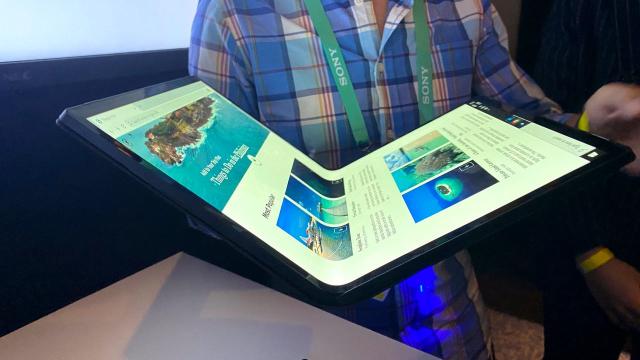2019 was the year of the foldable phone. At least in theory.
In practice it didn’t work out quite so well. Samsung’s Galaxy Fold was delayed after significant screen issues, and Huawei’s Mate X was only released in limited markets. And let’s not forget Royole’s Flexpai.
But the thirst for foldable devices is still strong, In fact, the tech has made it into a few laptops at CES 2020. I had a chance to try Intel’s prototype briefly in the bowels of a Vegas hotel.
[referenced url=”https://gizmodo.com.au/2019/01/hands-on-royole-flexpai-first-look-with-the-first-foldable-phone/” thumb=”https://gizmodo.com.au/wp-content/uploads/2019/01/foldable-butt-410×231.jpeg” title=”Hands On With The First Foldable Phone” excerpt=”In the last few months of 2018 it seemed like the mobile world was dominated by the foldable arms race. Samsung was always at the forefront of the conversation, but there were other contenders who might get there first, including Huawei. In the end, a small company called Royole beat everyone to it, releasing its foldable to the commercial Chinese market at the end of last year. It also made an appearance at CES 2019, so I pushed my way through the crowds to ensure I got my hands (and butt) on it.”]
What is it?
[clear]
This flappy boi is Intel’s prototype foldable PC and is rather cutely named ‘Horseshoe Bend’ after the the curve it creates when it is folded in half.
It has a 17.3-inch display and can be used in laptop and tablet modes. It has a built in kick stand for the latter, as well as a separate wireless keyboard that can be utilised in laptop mode. It can even be magnetically attached to the bottom half of the screen.There were no divulged specs, sorry!
The most important thing to remember is it’s just a concept device – it will not be released to the public. That also means no specs were divulged – sorry!
The purpose of the model is to convince laptop brands to utilise the tech and collaborate with Intel when it comes to manufacturing foldable PCs in the future.
It also gives us insight into how larger foldables are likely to work and what they’ll look like over the next few years.
What’s good about it?
Everyone wanted a piece of this thing at Intel’s media event, so time was scarce.
But during those precious minutes I was able to test its scrolling and in-screen typing capabilities in goth modes.
I expected to despise typing directly onto the folded display, but it actually felt good against my finger tips. And I was pleasantly surprised by the lack of delay or glitches when it came to scrolling through online and offline content.
A bendable laptop is quite a site to behold, and fortunately the Horseshow Bend didn’t turn out gimmicky. Despite its mammoth size, it looked sleek, slim and sexy. It was easy to forget that its a 17.3-inch laptop.
The only time its size really stood out was in tablet mode. This was also where the kickstand and wireless keyboard came in handy. They were nice touches that elevated the tablet experience.
I was also impressed by the implied battery life. There’s not actually a number attached because of its prototype status, but the demonstrator revealed that it had mostly been unplugged for demonstrations for over 4 hours.
This may not seem great but I expected it to be abysmal due to the size and being an almost all-screen laptop.
While we can expect the first foldable PCs to have worse battery lives than their regular counterparts, they may end up being better than we thought.
What’s not so good?
It seems like the screen itself is probably still a bit on the delicate side – the demonstrator wouldn’t fold it in half for anyone. However, a source did reveal that it was being folded earlier in the day and that the screen stopped working when they went to try the laptop.
I also found 17.3-inches to be little large. Tablet mode seemed way too big for a regular consumer use case. While it would be fine for a desk, it’s not going to be comfortable for commuting.
That being said, this is could be chalked up to personal preference – I don’t tend to like laptops over 25 inches. But I do think the 17-inch tablet mode would be perfect for the workplace and during conventions.
Should you buy it?
You can’t.
But even my limited time with it convinced me of the eventual popularity of full-screen foldable laptops.
They’re going to look good, provide multiple display options and be great for multi-tasking. Plus they’ll be magical to play with.
They’ll probably be ludicrously expensive at first, but if foldable PCs do become normalised and come down in price, I will probably want one.
[referenced url=”https://gizmodo.com.au/2020/01/foldable-phones-and-pcs-are-just-tablets/” thumb=”https://i.kinja-img.com/gawker-media/image/upload/t_ku-large/m1ryvvzox2sdk90khadx.jpg” title=”Foldable Phones And PCs Are Just Tablets” excerpt=”I will admit I’m partially to blame. I’ve edited a lot of Gizmodo stories about the new category of devices that look like a laptop or phone when closed, but open up into impressive-looking tablets. In the course of editing those stories, I have furthered the characterisation of these devices as folding phones and PCs. The companies call them that, and we reporters refer to them as such for the sake of accuracy.”]
The author travelled to CES 2020 on a scholarship from the Consumer Technology Association.
